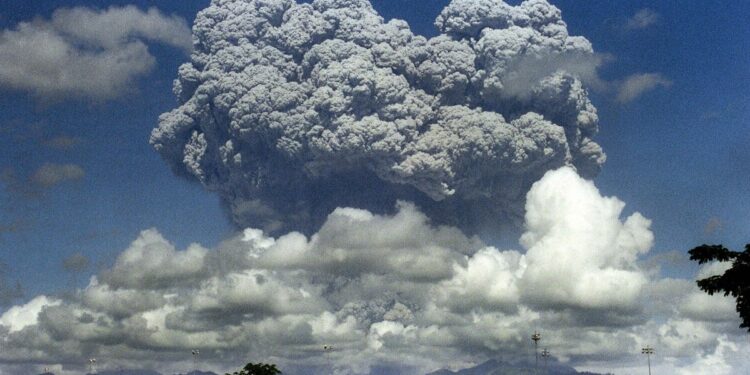The eruption of the Hunga-Tonga-Hunga-Ha’apai volcano this weekend sent a massive cloud of ash high into the atmosphere and generated a tsunami that impacted much of the Pacific Rim. As of this writing, the damage from the eruption to Tonga and surrounding nations is just beginning to become known, with widespread destruction reported on the islands. Scientists have long known that large volcanic eruptions can have an immediate and years-long impact on the global climate, and an entire field of study has evolved to better understand the mechanisms. Early data from this weekend’s eruption, however, has indicated it was much too small to have any meaningful impact on climate change.
One of the best known and studied volcanic events linked to a decline in global temperatures is the 1991 eruption of Mount Pinatubo in the Philippines. Over the course of three days, Pinatubo released somewhere between 6 and 22 million tons of sulfur dioxide in to the atmosphere, roughly equivalent to 20% of man-made SO2 released last year. Sulfate aerosols are reflective, scattering sunlight and reflecting some of it back to space. With sufficient quantities of these compounds in the atmosphere, enough light can be reflected away from earth to cool the planet.
Volcanic sulfates are especially good at impacting global climate. Man-made emissions, such as from power plants, are emitted at or near ground level and tend to remain in the atmosphere on the order of days or weeks, joining with water in the air and returning to earth as acid rain. During a massive volcanic eruption, however, much of the SO2 is lofted many miles up in to the stratosphere, above most clouds and weather, where they are only removed slowly over time through gravitational settling or large scale circulation. At that altitude, the aerosols remain for months to years. Pinatubo resulted in a global temperature decline of nearly 1 degree Fahrenheit during the year following its eruption.
Scientists studying this phenomenon have begun to research the purposeful release of sulfate or similar aerosols to cool the planet. So-called geoengineering would allow mankind to avoid the worst impacts of climate change by adding planet-wide cooling technology to our toolset. The technology isn’t a panacea, as even the most ardent supporters of the approach would agree. For one, sulfur compounds in the upper atmosphere have also been shown to attack the o-zone layer, and much of the sulfur eventually returns to the surface as acid rain. The approach also does nothing to inhibit other environmental impacts of anthropogenic carbon emissions, such as ocean acidification. Global cooling through geoengineering or the natural volcanic equivalent is no silver-bullet for climate change. Instead, its just one bad option in a narrowing set of tools at our disposal to avoid the worst, and scientists are working to understand the impacts and implications in case it becomes the least-bad option.
Hunga-Tonga-Hunga-Ha’apai, however, likely won’t serve as a test case, and won’t buy us time. Early data from earth observing satellites indicates that total sulfur dioxide emissions are roughly 1 to 2% of Pinatubo and nearly an order of magnitude too small to have any measurable climate impact. The eruption may still continue and more planet cooling gases could be released, but at this point our continued march to warmer temperatures and higher seas remains unabated. The usual solutions, from renewable energy to green hydrogen to carbon capture, remain our best tools to combat the climate crisis.











